Penguin
| Penguins Temporal range: Paleocene-Recent, 62–0 Ma |
|
|---|---|
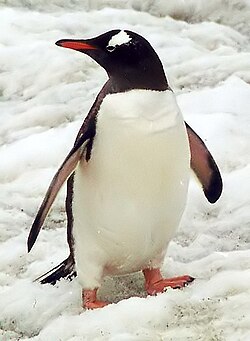 |
|
| Gentoo Penguin, Pygoscelis papua | |
| Scientific classification | |
| Kingdom: | Animalia |
| Phylum: | Chordata |
| Class: | Aves |
| Infraclass: | Neognathae |
| Order: | Sphenisciformes Sharpe, 1891 |
| Family: | Spheniscidae Bonaparte, 1831 |
 |
|
| Range of Penguins, all species (aqua)
Aptenodytes |
|
Penguins (order Sphenisciformes, family Spheniscidae) are a group of aquatic, flightless birds living almost exclusively in the southern hemisphere, especially in Antarctica. Highly adapted for life in the water, penguins have countershaded dark and white plumage, and their wings have evolved into flippers. Most penguins feed on krill, fish, squid, and other forms of sealife caught while swimming underwater. They spend about half of their lives on land and half in the oceans.
Although all penguin species are native to the southern hemisphere, they are not found only in cold climates, such as Antarctica. In fact, only a few species of penguin live so far south. Several species are found in the temperate zone, and one species, the Galápagos Penguin, lives near the equator.
The largest living species is the Emperor Penguin (Aptenodytes forsteri): on average adults are about 1.1 m (3 ft 7 in) tall and weigh 35 kg (75 lb) or more. The smallest penguin species is the Little Blue Penguin (Eudyptula minor), also known as the Fairy Penguin, which stands around 40 cm tall (16 in) and weighs 1 kg (2.2 lb). Among extant penguins, larger penguins inhabit colder regions, while smaller penguins are generally found in temperate or even tropical climates (see also Bergmann's Rule). Some prehistoric species attained enormous sizes, becoming as tall or as heavy as an adult human. These were not restricted to Antarctic regions; on the contrary, subantarctic regions harboured high diversity, and at least one giant penguin occurred in a region not quite 2,000 km south of the equator 35 mya, in a climate decidedly warmer than today.
Contents |
Etymology
The etymology of the word "penguin" is still debated. The English word is not apparently of French,[1] nor of Breton[2] or Spanish[3] origin (both attributed to the French word pingouin "auk"), but first appears in English or Dutch.[1]
Some dictionaries suggest a derivation from Welsh pen, "head" and gwyn, "white", including the Oxford English Dictionary,[4] the American Heritage Dictionary,[5] the Century Dictionary[6] and Merriam-Webster,[7] on the basis that the name was originally applied to the great auk, either because it was found on White Head Island (Welsh Pen Gwyn) in Newfoundland, or because it had white circles around its eyes (though the head was black).
An alternative etymology links the word to Latin pinguis which means "fat". In Dutch the alternative word for penguin is 'fat-goose' ('vetgans' see: Dutch wiki or dictionaries under Pinguïn), and would indicate this bird received its name from its perceived appearance.
A third theory states that the word is an alteration of “pen-wing”, with reference to the rudimentary wings of great auks. This has been criticised for the unexplained nature of the alteration of the word.[6]
Systematics and evolution
Living species and recent extinctions

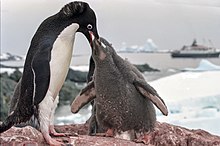

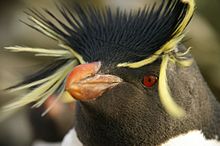

The number of extant penguin species is debated. Depending on which authority is followed, penguin biodiversity varies between 17 and 20 living species, all in the subfamily Spheniscinae. Some sources consider the White-flippered Penguin a separate Eudyptula species, while others treat it as a subspecies of the Little Penguin;[8][9] the actual situation seems to be more complicated.[10] Similarly, it is still unclear whether the Royal Penguin is merely a color morph of the Macaroni penguin. The status of the Rockhopper penguins is also unclear.
Updated after Marples (1962), Acosta Hospitaleche (2004), and Ksepka et al. (2006).
Subfamily Spheniscinae – Modern penguins
- Aptenodytes – Great penguins
- King Penguin, Aptenodytes patagonicus
- Emperor Penguin, Aptenodytes forsteri
- Pygoscelis – Brush-tailed penguins
- Adélie Penguin, Pygoscelis adeliae
- Chinstrap Penguin, Pygoscelis antarctica
- Gentoo Penguin, Pygoscelis papua
- Eudyptula – Little penguins
- Little Blue Penguin, Eudyptula minor
- White-flippered Penguin, Eudyptula albosignata (provisional)
- Spheniscus – Banded penguins
- Magellanic Penguin, Spheniscus magellanicus
- Humboldt Penguin, Spheniscus humboldti
- Galapagos Penguin, Spheniscus mendiculus
- African Penguin, Spheniscus demersus
- Megadyptes
- Yellow-eyed Penguin, Megadyptes antipodes
- Waitaha Penguin, Megadyptes waitaha (extinct)
- Eudyptes – Crested penguins
- Fiordland Penguin, Eudyptes pachyrynchus
- Snares Penguin, Eudyptes robustus
- Erect-crested Penguin, Eudyptes sclateri
- Western Rockhopper Penguin, Eudyptes chrysocome
- Eastern Rockhopper Penguin, Eudyptes filholi
- Northern Rockhopper Penguin, Eudyptes moseleyi
- Royal Penguin, Eudyptes schlegeli (disputed)
- Macaroni Penguin, Eudyptes chrysolophus
- Chatham Penguin, Eudyptes sp. (extinct)
Fossil genera
Order Sphenisciformes
- Basal and unresolved taxa (all fossil)
- Waimanu – basal (Middle-Late Paleocene)
- Perudyptes (Middle Eocene of Atacama Desert, Peru) – basal?
- Spheniscidae gen. et sp. indet. CADIC P 21 (Leticia Middle Eocene of Punta Torcida, Argentina)[11]
- Delphinornis (Middle/Late Eocene? – Early Oligocene of Seymour Island, Antarctica) – Palaeeudyptinae, basal, new subfamily 1?
- Archaeospheniscus (Middle/Late Eocene – Late Oligocene) – Palaeeudyptinae? New subfamily 2?
- Marambiornis (Late Eocene –? Early Oligocene of Seymour Island, Antarctica) – Palaeeudyptinae, basal, new subfamily 1?
- Mesetaornis (Late Eocene –? Early Oligocene of Seymour Island, Antarctica) – Palaeeudyptinae, basal, new subfamily 1?
- Tonniornis (Late Eocene –? Early Oligocene of Seymour Island, Antarctica)
- Wimanornis (Late Eocene –? Early Oligocene of Seymour Island, Antarctica)
- Duntroonornis (Late Oligocene of Otago, New Zealand) – possibly Spheniscinae
- Korora (Late Oligocene of S Canterbury, New Zealand)
- Kairuku (Late Oligocene of E South Island, New Zealand)
- Platydyptes (Late Oligocene of New Zealand) – possibly not monophyletic; Palaeeudyptinae, Paraptenodytinae or new subfamily?[12]
- Spheniscidae gen. et sp. indet. (Late Oligocene/Early Miocene of Hakataramea, New Zealand)[verification needed]
- Madrynornis (Puerto Madryn Late Miocene of Argentina) – possibly Spheniscinae
- Pseudaptenodytes (Late Miocene/Early Pliocene)
- Dege (Early Pliocene of South Africa) – possibly Spheniscinae
- Marplesornis (Early Pliocene) – possibly Spheniscinae
- Nucleornis (Early Pliocene of Duinfontain, South Africa) – possibly Spheniscinae
- Inguza (Late Pliocene) – probably Spheniscinae; formerly Spheniscus predemersus
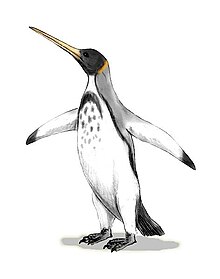
- Family Spheniscidae
- Subfamily Palaeeudyptinae – Giant penguins (fossil)
- Crossvallia (Cross Valley Late Paleocene of Seymour Island, Antarctica) – tentatively assigned to this subfamily
- Anthropornis (Middle Eocene? – Early Oligocene of Seymour Island, Antarctica) – tentatively assigned to this subfamily
- Nordenskjoeld's Giant Penguin, Anthropornis nordenskjoeldi
- Icadyptes (Late Eocene of Atacama Desert, Peru)
- Palaeeudyptes (Middle/Late Eocene – Late Oligocene) – polyphyletic; some belong in other subfamilies
- Pachydyptes (Late Eocene)
- Anthropodyptes (Middle Miocene) – tentatively assigned to this subfamily
- Subfamily Paraptenodytinae – Stout-footed penguins (fossil)
- Arthrodytes (San Julian Late Eocene/Early Oligocene – Patagonia Early Miocene of Patagonia, Argentina)
- Paraptenodytes (Early – Late Miocene/Early Pliocene)
- Subfamily Palaeospheniscinae – Slender-footed penguins (fossil)
- Eretiscus (Patagonia Early Miocene of Patagonia, Argentina)
- Palaeospheniscus (Early? – Late Miocene/Early Pliocene) – includes Chubutodyptes
- Subfamily Palaeeudyptinae – Giant penguins (fossil)
The Early Oligocene genus Cruschedula was formerly thought to belong to Spheniscidae, however reexamination of the holotype in 1943 resulted in the genus being placed in Accipitridae.[13] Further examination in 1980 resulted in placement as Aves incertae sedis.[14]
Taxonomy
Some recent sources[15] apply the phylogenetic taxon Spheniscidae to what here is referred to as Spheniscinae. Furthermore, they restrict the phylogenetic taxon Sphenisciformes to flightless taxa, and establish the phylogenetic taxon Pansphenisciformes as equivalent to the Linnean taxon Sphenisciformes,[16] i.e., including any flying basal "proto-penguins" to be discovered eventually. Given that neither the relationships of the penguin subfamilies to each other nor the placement of the penguins in the avian phylogeny is presently resolved, this is confusing, so the established Linnean system is thus followed here.
Evolution
The evolutionary history of penguins is well-researched and represents a showcase of evolutionary biogeography; though as penguin bones of any one species vary much in size and few good specimens are known, the alpha taxonomy of many prehistoric forms still leaves much to be desired. Some seminal articles about penguin prehistory have been published since 2005,[17][18][19][20] the evolution of the living genera can be considered resolved by now.
The basal penguins lived around the time of the Cretaceous–Paleogene extinction event somewhere in the general area of (southern) New Zealand and Byrd Land, Antarctica.[19] Due to plate tectonics, these areas were at that time less than 1,500 kilometres (930 mi) apart rather than the 4,000 kilometres (2,500 mi) of today. The most recent common ancestor of penguins and their sister clade can be roughly dated to the Campanian–Maastrichtian boundary, around 70–68 mya.[18][20][21] What can be said as certainly as possible in the absence of direct (i.e., fossil) evidence is that by the end of the Cretaceous, the penguin lineage must have been evolutionarily well distinct, though much less so morphologically; it is fairly likely that they were not yet entirely flightless at that time, as flightless birds have generally low resilience to the breakdown of trophic webs that follows the initial phase of mass extinctions because of their below-average dispersal capabilities (see also Flightless Cormorant).[citation needed]
The basal fossils
The oldest known fossil penguin species is Waimanu manneringi, which lived in the early Paleocene epoch of New Zealand, or about 62 mya.[20] While they were not as well-adapted to aquatic life as modern penguins, Waimanu were generally loon-like birds but already flightless, with short wings adapted for deep diving.[20] They swam on the surface using mainly their feet, but the wings were – as opposed to most other diving birds, living and extinct – already adapting to underwater locomotion.[citation needed]
Perudyptes from northern Peru was dated to 42 mya. An unnamed fossil from Argentina proves that by the Bartonian (Middle Eocene), some 39–38 mya,[22] primitive penguins had spread to South America and were in the process of expanding into Atlantic waters.[16]
Palaeeudyptines
During the Late Eocene and the Early Oligocene (40–30 mya), some lineages of gigantic penguins existed. Nordenskjoeld's Giant Penguin was the tallest, growing nearly 1.80 meters (6 ft) tall. The New Zealand Giant Penguin was probably the heaviest, weighing 80 kg or more. Both were found on New Zealand, the former also in the Antarctic farther eastwards.
Traditionally, most extinct species of penguins, giant or small, had been placed in the paraphyletic subfamily called Palaeeudyptinae. More recently, with new taxa being discovered and placed in the phylogeny if possible, it is becoming accepted that there were at least two major extinct lineages. One or two closely related ones occurred in Patagonia, and at least one other—which is or includes the paleeudyptines as recognized today – occurred on most Antarctic and subantarctic coasts.
But size plasticity seems to have been great at this initial stage of penguin radiation: on Seymour Island, Antarctica, for example, around 10 known species of penguins ranging in size from medium to huge apparently coexisted some 35 mya during the Priabonian (Late Eocene).[23] It is not even known whether the gigantic palaeeudyptines constitute a monophyletic lineage, or whether gigantism was evolved independently in a much restricted Palaeeudyptinae and the Anthropornithinae – whether they were considered valid, or whether there was a wide size range present in the Palaeeudyptinae as delimited as usually done these days (i.e., including Anthropornis nordenskjoeldi).[19] The oldest well-described giant penguin, the 5-foot (1.5 m)-tall Icadyptes salasi, actually occurred as far north as northern Peru about 36 mya.
In any case, the gigantic penguins had disappeared by the end of the Paleogene, around 25 mya. Their decline and disappearance coincided with the spread of the Squalodontoidea and other primitive, fish-eating toothed whales, which certainly competed with them for food, and were ultimately more successful.[18] A new lineage, the Paraptenodytes, which includes smaller but decidedly stout-legged forms, had already arisen in southernmost South America by that time. The early Neogene saw the emergence of yet another morphotype in the same area, the similarly sized but more gracile Palaeospheniscinae, as well as the radiation that gave rise to the penguin biodiversity of our time.
Origin and systematics of modern penguins
Modern penguins consititute two undisputed clades and another two more basal genera with more ambiguous relationships.[17] The origin of the Spheniscinae lies probably in the latest Paleogene, and geographically it must have been much the same as the general area in which the order evolved: the oceans between the Australia-New Zealand region and the Antarctic.[18] Presumedly diverging from other penguins around 40 mya,[18] it seems that the Spheniscinae were for quite some time limited to their ancestral area, as the well-researched deposits of the Antarctic Peninsula and Patagonia have not yielded Paleogene fossils of the subfamily. Also, the earliest spheniscine lineages are those with the most southern distribution.
The genus Aptenodytes appears to be the basalmost divergence among living penguins[24][25] they have bright yellow-orange neck, breast, and bill patches; incubate by placing their eggs on their feet, and when they hatch the chicks are almost naked. This genus has a distribution centered on the Antarctic coasts and barely extends to some subantarctic islands today.
Pygoscelis contains species with a fairly simple black-and-white head pattern; their distribution is intermediate, centered on Antarctic coasts but extending somewhat northwards from there. In external morphology, these apparently still resemble the common ancestor of the Spheniscinae, as Aptenodytes' autapomorphies are in most cases fairly pronounced adaptations related to that genus' extreme habitat conditions. As the former genus, Pygoscelis seems to have diverged during the Bartonian,[26] but the range expansion and radiation that led to the present-day diversity probably did not occur until much later; around the Burdigalian stage of the Early Miocene, roughly 20–15 mya.[18]
The genera Spheniscus and Eudyptula contain species with a mostly subantarctic distribution centered on South America; some, however, range quite far northwards. They all lack carotenoid coloration, and the former genus has a conspicuous banded head pattern; they are unique among living penguins by nesting in burrows. This group probably radiated eastwards with the Antarctic Circumpolar Current out of the ancestral range of modern penguins throughout the Chattian (Late Oligocene), starting approximately 28 mya.[18] While the two genera separated during this time, the present-day diversity is the result of a Pliocene radiation, taking place some 4–2 mya.[18]
The Megadyptes–Eudyptes clade occurs at similar latitudes (though not as far north as the Galapagos Penguin), has its highest diversity in the New Zealand region, and represent a westward dispersal. They are characterized by hairy yellow ornamental head feathers; their bills are at least partly red. These two genera diverged apparently in the Middle Miocene (Langhian, roughly 15–14 mya), but again, the living species of Eudyptes are the product of a later radiation, stretching from about the late Tortonian (Late Miocene, 8 mya) to the end of the Pliocene.[18]
The geographical and temporal pattern or spheniscine evolution corresponds closely to two episodes of global cooling documented in the paleoclimatic record.[18] The emergence of the subantarctic lineage at the end of the Bartonian corresponds with the onset of the slow period of cooling that eventually led to the ice ages some 35 million years later. With habitat on the Antarctic coasts declining, by the Priabonian more hospitable conditions for most penguins existed in the subantarctic regions rather than in Antarctica itself.[27] Notably, the cold Antarctic Circumpolar Current also started as a continuous circumpolar flow only around 30 mya, on the one hand forcing the Antarctic cooling, and on the other facilitating the eastward expansion of Spheniscus to South America and eventually beyond.[18] Despite this, there is no fossil evidence to support the idea of a crown radiation from the antarctic continent in the Paleogene.[27]
Later, an interspersed period of slight warming was ended by the Middle Miocene Climate Transition, a sharp drop in global average temperature from 14–12 mya, and similar abrupt cooling events followed at 8 mya and 4 mya; by the end of the Tortonian, the Antarctic ice sheet was already much like today in volume and extent. The emergence of most of today's subantarctic penguin species almost certainly was caused by this sequence of Neogene climate shifts.
Relationship to other bird orders
Penguin ancestry beyond Waimanu remains unknown and not well-resolved by molecular or morphological analyses. The latter tend to be confounded by the strong adaptive autapomorphies of the Sphenisciformes; a sometimes perceived fairly close relationship between penguins and grebes is almost certainly an error based on both groups' strong diving adaptations, which are homoplasies. On the other hand, different DNA sequence datasets do not agree in detail with each other either.

What seems clear is that penguins belong to a clade of Neoaves (living birds except paleognaths and fowl) that comprises what is sometimes called "higher waterbirds" to distinguish them from the more ancient waterfowl. This group contains such birds as storks, rails, and the seabirds, with the possible exception of the Charadriiformes.[28]
Inside this group, penguin relationships are far less clear. Depending on the analysis and dataset, a close relationship to Ciconiiformes[20] or to Procellariiformes[18] has been suggested. Some think the penguin-like plotopterids (usually considered relatives of anhingas and cormorants) may actually be a sister group of the penguins, and that penguins may have ultimately shared a common ancestor with the Pelecaniformes and consequently would have to be included in that order, or that the plotopterids were not as close to other pelecaniforms as generally assumed, which would necessitate splitting the traditional Pelecaniformes in three.[29]
Anatomy and physiology

Penguins are superbly adapted to aquatic life. Their vestigial wings have become flippers, useless for flight in the air. In the water, however, penguins are astonishingly agile. Penguins' swimming looks very similar to bird's flight in the air.[30] Within the smooth plumage a layer of air is preserved, ensuring buoyancy. The air layer also helps insulate the birds in cold waters. On land, penguins use their tails and wings to maintain balance for their upright stance.
All penguins are countershaded for camouflage – that is, they have black backs and wings with white fronts.[31] A predator looking up from below (such as an orca or a leopard seal) has difficulty distinguishing between a white penguin belly and the reflective water surface. The dark plumage on their backs camouflages them from above.
Diving penguins reach 6 to 12 km/h (3.7 to 7.5 mph), though there are reports of velocities of 27 km/h (17 mph) (which are more realistic in the case of startled flight).[citation needed] The small penguins do not usually dive deep; they catch their prey near the surface in dives that normally last only one or two minutes. Larger penguins can dive deep in case of need. Dives of the large Emperor Penguin have been recorded reaching a depth of 565 m (1,870 ft) for up to 22 minutes.
Penguins either waddle on their feet or slide on their bellies across the snow, a movement called "tobogganing", which conserves energy while moving quickly. They also jump with both feet together if they want to move more quickly or cross steep or rocky terrain.
Penguins have an average sense of hearing for birds;[32] this is used by parents and chicks to locate one another in crowded colonies.[33] Their eyes are adapted for underwater vision, and are their primary means of locating prey and avoiding predators; in air it has been suggested that they are nearsighted, although research has not supported this hypothesis.[34]

Penguins have a thick layer of insulating feathers that keeps them warm in water (heat loss in water is much greater than in air). The Emperor Penguin (the largest penguin) has the largest body mass of all penguins, which further reduces relative surface area and heat loss. They also are able to control blood flow to their extremities, reducing the amount of blood that gets cold, but still keeping the extremities from freezing. In the extreme cold of the Antarctic winter, the females are at sea fishing for food leaving the males to brave the weather by themselves. They often huddle together to keep warm and rotate positions to make sure that each penguin gets a turn in the center of the heat pack.
They can drink salt water because their supraorbital gland filters excess salt from the bloodstream.[35][36][37] The salt is excreted in a concentrated fluid from the nasal passages.
The Great Auk of the Northern Hemisphere, now extinct, was superficially similar to penguins, and the word "penguin" was originally used for that bird, centuries ago. They are not related to the penguins at all, but are an example of convergent evolution.[38]
Isabelline penguins
Perhaps one in 50,000 penguins (of most species) are born with brown rather than black plumage. These are called isabelline penguins, possibly in reference to the legend that the archduchess Isabella of Austria vowed not to change her undergarments until her husband's siege of Ostend was successful—which took over three years to accomplish.[39] Isabellinism is different from albinism. Isabelline penguins tend to live shorter lives than normal penguins, as they are not well-camouflaged against the deep, and are often passed over as mates.
Distribution and habitat
Although all penguin species are native to the southern hemisphere, they are not found only in cold climates, such as Antarctica. In fact, only a few species of penguin actually live so far south. At least 10[verification needed] species live in the temperate zone; one, the Galápagos Penguin, lives as far north as the Galápagos Islands, but this is only made possible by the cold, rich waters of the Antarctic Humboldt Current that flows around these islands.[40]
Several authors have suggested that penguins are a good example of Bergmann's Rule [41][42] where larger bodied populations live at higher latitudes than smaller bodied populations. There is some disagreement about this, and several other authors have noted that there are fossil penguin species that contradict this hypothesis and that ocean currents and upwellings are likely to have had a greater effect on species diversity than latitude alone.[43][44]
Major populations of penguins are found in: Antarctica, Argentina, Australia, Chile, New Zealand, and South Africa.[45][46]
Behaviour
Breeding
Penguins for the most part breed in large colonies, the exceptions being the Yellow-eyed and Fiordland species; these colonies may range in size from as few as a 100 pairs for Gentoo Penguins, to several hundred thousand in the case of King, Macaroni and Chinstrap Penguins.[47] Living in colonies results in a high level of social interaction between birds, which has led to a large repertoire of visual as well as vocal displays in all penguin species.[48] Agonistic displays are those intended to confront or drive off, or alternately appease and avoid conflict with, other individuals.[48]
Penguins form monogamous pairs for a breeding season, though the rate the same pair recouples varies drastically. Most penguins lay two eggs in a clutch, although the two largest species, the Emperor and the King Penguins, lay only one.[49] With the exception of the Emperor Penguin, where the male does it all, all penguins share the incubation duties.[50] These incubation shifts can last days and even weeks as one member of the pair feeds at sea.
Penguins generally only lay one brood; the exception is the Little Penguin, which can raise two or three broods in a season.[51]
Penguin eggs are smaller than any other bird species when compared proportionally to the weight of the parent birds; at 52 g (2 oz), the Little Penguin egg is 4.7% of its mothers' weight, and the 450 g (1 lb) Emperor Penguin egg is 2.3%.[49] The relatively thick shell forms between 10 and 16 % of the weight of a penguin egg, presumably to minimise risk of breakage in an adverse nesting environment. The yolk, too, is large, and comprises 22–31 % of the egg. Some yolk often remains when a chick is born, and is thought to help sustain it if parents are delayed in returning with food.[52]
When mothers lose a chick, they sometimes attempt to "steal" another mother's chick, usually unsuccessfully as other females in the vicinity assist the defending mother in keeping her chick.[citation needed] In some species, such as Emperor Penguins, young penguins assemble in large groups called crèches.
Penguins and humans

Penguins seem to have no special fear of humans, and have approached groups of explorers without hesitation. This is probably because penguins have no land predators in Antarctica or the nearby offshore islands. Instead, penguins are at risk at sea from predators such as the leopard seal. Typically, penguins do not approach closer than about 3 meters (10 ft) at which point they become nervous. This is also the distance that Antarctic tourists are told to keep from penguins (tourists are not supposed to approach closer than 3 meters, but are not expected to withdraw if the penguins come closer).
In popular culture
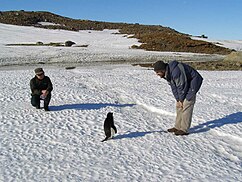
Penguins are popular around the world, primarily for their unusually upright, waddling gait and (compared to other birds) lack of fear of humans. Their striking black-and-white plumage is often likened to a tuxedo suit. Mistakenly, some artists and writers have penguins based at the North Pole. This is incorrect, as there are almost no wild penguins in the northern hemisphere, except the small group on the northernmost of the Galápagos. The cartoon series Chilly Willy helped perpetuate this myth, as the title penguin would interact with northern-hemisphere species such as polar bears and walruses.
Penguins have been the subject of many books and films such as Happy Feet, Surf's Up and The Penguins of Madagascar, all CGI films; March of the Penguins, a documentary based on the migration process of the Emperor Penguin; and a parody titled Farce of the Penguins. Mr. Popper's Penguins is a children's book written by Richard & Florence Atwater; it was named a Newbery Honor Book in 1939. Penguins have also found their way into a number of cartoons and television dramas; perhaps the most notable of these is Pingu, created by Silvio Mazzola in 1986 and covering more than 100 short episodes. Entertainment Weekly put it on its end-of-the-decade, "best-of" list, saying, "Whether they were walking (March of the Penguins), dancing (Happy Feet), or hanging ten (Surf's Up), these oddly adorable birds took flight at the box office all decade long."[53]
Several pro, minor, college and high school sport teams have named themselves after the species, with the Pittsburgh Penguins team in the National Hockey League and the Youngstown State Penguins being the most recognizable.
The tendency of penguins to form large groups feeds the stereotype that they all look exactly alike, a popular notion exploited by cartoonists such as Gary Larson.
Penguins featured regularly in the cartoons of UK cartoonist Steve Bell in his strip in The Guardian Newspaper, particularly during and following the Falklands War.
In the mid-2000s, penguins became one of the most publicized species of animals that form lasting homosexual couples. A children's book, And Tango Makes Three, was written about one such penguin family in the New York Zoo.
References
Footnotes
- ^ a b "PINGOUIN : Etymologie de PINGOUIN". Centre National de Ressources Textuelles et Lexicales. http://www.cnrtl.fr/etymologie/pingouin. Retrieved 2010-01-25.
- ^ Online Etymology Dictionary Accessed 2010-01-25
- ^ Diccionario de la lengua española Accessed on 2010-01-25.
- ^ Oxford English Dictionary. Accessed 2007-03-21
- ^ American Heritage Dictionary at wordnik.com Accessed 2010-01-25
- ^ a b Century Dictionary at wordnik.com Accessed 2010-01-25
- ^ Merriam-Webster Accessed 2010-01-25
- ^ Williams, (1995).
- ^ Davis & Renner, (2003).
- ^ Banks et al. (2002).
- ^ Clarke et al. (2003)
- ^ "Platydyptes novaezealandiae; holotype". Collections Online. Museum of New Zealand Te Papa Tongarewa. http://collections.tepapa.govt.nz/objectdetails.aspx?oid=314359. Retrieved 16 July 2010.
- ^ Simpson, G.G. (1946). "Fossil penguins". Bulletin of the American Museum of Natural History 81. http://digitallibrary.amnh.org/dspace/bitstream/2246/392/1/B087a01.pdf.
- ^ Olson, S.L. (1985). "Faunal Turnover in South American Fossil Avifaunas: The Insufficiencies of the Fossil Record". Evolution 39 (5): 1174–1177. doi:10.2307/2408747. JSTOR 2408747. http://si-pddr.si.edu/dspace/bitstream/10088/6499/1/VZ_169_S_Amer_fossil_avifaunas.pdf.
- ^ E.g. Clarke et al. (2003), Ksepka et al. (2006)
- ^ a b Clarke et al. (2003).
- ^ a b Bertelli & Giannini, (2005).
- ^ a b c d e f g h i j k l Baker et al. (2006).
- ^ a b c Ksepka et al. (2006).
- ^ a b c d e Slack et al. (2006).
- ^ The exact divergence dates according to Baker et al. (2006) mentioned in this section are not as precisely resolved as it appears to be due to uncertainties of the molecular clock used.
- ^ Contra Baker et al. (2006).
- ^ Jadwiszczak, (2006).
- ^ Christidis L, Boles WE (2008). Systematics and Taxonomy of Australian Birds. Canberra: CSIRO Publishing. p. 97. ISBN 978-0-643-06511-6.
- ^ Ksepka, D. T. B., Sara; Giannini, Norberto P; (2006). "The phylogeny of the living and fossil Sphenisciformes (penguins)". Cladistics 22 (5): 412–441. doi:10.1111/j.1096-0031.2006.00116.x.
- ^ In fact, it is fairly likely that during the Bartonian, there was a near-synchronous but allopatric split between the ancestors of Aptenodytes, Pygoscelis, and the common ancestor of all remaining genera [Baker et al. (2006)].
- ^ a b Baker, A., Pereira, SL, Haddrath, OP, Edge, KA (2006). "Multiple gene evidence for expansion of extant penguins out of Antarctica due to global cooling". Proceedings of the Royal Society B-Biological Sciences 273.
- ^ Fain & Houde, (2004).
- ^ Mayr, (2005).
- ^ Penguin swimming under water, Galapagos — Youtube video
- ^ Buskey, Theresa. "The Antarctic Polar Region". In Alan Christopherson, M.S.. The Polar Regions. LIFEPAC. 804 N. 2nd Ave. E., Rock Rapids, IA: Alpha Omegan Publications, Inc. ISBN 978-1-58095-156-2.
- ^ Wever et al. (1969).
- ^ Jouventin et al. (1999).
- ^ Sivak et al. (1987).
- ^ "Animal Fact Sheets". http://www.zoo.org/educate/fact_sheets/penguin/penguin.htm. Retrieved 2006-07-21.
- ^ "Humboldt Penguin: Saint Louis Zoo". http://www.stlzoo.org/animals/abouttheanimals/birds/penguins/humboldtpenguin.htm. Retrieved 2006-07-21.
- ^ "African Penguins and Penguins of the World". http://users.iafrica.com/b/bo/boulders/Vans%20book.htm. Retrieved 2006-07-21.
- ^ Convergence and divergence in the evolution of aquatic birds by Marcel Van Tuinen, Dave Brian Butvill, John A. W. Kirsch and S. Blair Hedges.
- ^ David A Everitt and Colin M. Miskelly (2003). "A Review of Isabellinisn in Penguins" (PDF). The Ornithological Society of New Zealand, Inc. Archived from the original on 2007-08-08. http://web.archive.org/web/20070808182344/http://www.notornis.org.nz/free_issues/Notornis_50-2003/Notornis_50_1_43.pdf. Retrieved 2011-12-01.
- ^ Piper, Ross (2007), Extraordinary Animals: An Encyclopedia of Curious and Unusual Animals, Greenwood Press.
- ^ Ashton, K. (2002). "Patterns of within-species body size variation of birds: strong evidence for Bergmann's rule". Global Ecology and Biogeography 11 (6): 505–523. doi:10.1046/j.1466-822X.2002.00313.x.
- ^ Meiri S, D. T. (2003). "On the validity of Bergmann's rule". Journal of Biogeography 30 (3): 331–351. doi:10.1046/j.1365-2699.2003.00837.x.
- ^ Clarke, J. A., Ksepka, Daniel T., Stucchie, Marcelo, Urbina, Mario, Giannini, Norberto, Bertelli, Sara, Narvez, Yanina, Boyd, Clint A. (2007). "Paleogene equatorial penguins challenge the proposed relationship between biogeography, diversity, and Cenozoic climate change". Proceedings of the National Academy of Sciences of the United States of America 104 (28): 11545–11550. doi:10.1073/pnas.0611099104. PMC 1913862. PMID 17601778. //www.pubmedcentral.nih.gov/articlerender.fcgi?tool=pmcentrez&artid=1913862.
- ^ Gohlich, U. B. (2007). "The oldest fossil record of the extant penguin genus Spheniscus-- a new species from the Miocene of Peru". Acta Palaeontologica Polonica 52: 285–298.
- ^ Penguins of Australia and New Zealand
- ^ Jadwiszczak, P. (2009). "Penguin past: The current state of knowledge". Polish Polar Research 30: 3–28.
- ^ Williams (The Penguins) p. 17
- ^ a b Williams (The Penguins) p. 57
- ^ a b Williams (The Penguins) p. 23
- ^ Numata, M; Davis, L & Renner, M (2000) "Prolonged foraging trips and egg desertion in little penguins (Eudyptula minor)". New Zealand Journal of Zoology 27: 291-298
- ^ Reilly PN, Balmford P (1975). "A breeding study of the little penguin, Eudyptula minor, in Australia". In Stonehouse, Bernard. The Biology of Penguins. London: Macmillan. pp. 161–87. ISBN 0-333-16791-0.
- ^ Williams (The Penguins) p. 24
- ^ Geier, Thom; Jensen, Jeff; Jordan, Tina; Lyons, Margaret; Markovitz, Adam; Nashawaty, Chris; Pastorek, Whitney; Rice, Lynette; Rottenberg, Josh; Schwartz, Missy; Slezak, Michael; Snierson, Dan; Stack, Tim; Stroup, Kate; Tucker, Ken; Vary, Adam B.; Vozick-Levinson, Simon; Ward, Kate (December 11, 2009), "THE 100 Greatest MOVIES, TV SHOWS, ALBUMS, BOOKS, CHARACTERS, SCENES, EPISODES, SONGS, DRESSES, MUSIC VIDEOS, AND TRENDS THAT ENTERTAINED US OVER THE PAST 10 YEARS". Entertainment Weekly. (1079/1080):74-84
Bibliography
- Two new fossil penguin species found in Peru
- (Spanish) Acosta Hospitaleche, Carolina (2004): Los pingüinos (Aves, Sphenisciformes) fósiles de Patagonia. Sistemática, biogeografía y evolución. Doctoral thesis, Department of Natural Sciences and Museum, Universidad Nacional de La Plata. La Plata, Argentina. PDF fulltext
- Baker, Allan J.; Pereira, Sergio Luiz; Haddrath, Oliver P. & Edge, Kerri-Anne (2006): Multiple gene evidence for expansion of extant penguins out of Antarctica due to global cooling. Proc. R. Soc. B 273: 11-17. doi:10.1098/rspb.2005.3260PDF fulltext
- Banks, Jonathan C.; Mitchell, Anthony D.; Waas, Joseph R. & Paterson, Adrian M. (2002): An unexpected pattern of molecular divergence within the blue penguin (Eudyptula minor) complex. Notornis 49(1): 29–38. PDF fulltext
- Bertelli, Sara & Giannini, Norberto P. (2005): A phylogeny of extant penguins (Aves: Sphenisciformes) combining morphology and mitochondrial sequences. Cladistics 21(3): 209–239. doi:10.1111/j.1096-0031.2005.00065.x (HTML abstract)
- Clarke, Julia A.; Olivero, Eduardo B. & Puerta, Pablo (2003): Description of the earliest fossil penguin from South America and first Paleogene vertebrate locality of Tierra Del Fuego, Argentina. American Museum novitates 3423: 1-18. PDF fulltext
- Davis; Lloyd S. & Renner; M. (1995). Penguins . London: T & A D Poyser. ISBN 0-7136-6550-5
- Fain, Matthew G. & Houde, Peter (2004): Parallel radiations in the primary clades of birds. Evolution 58(11): 2558-2573. doi:10.1554/04-235 PMID 15612298 PDF fulltext
- Jadwiszczak, Piotr (2006): Eocene penguins of Seymour Island, Antarctica: taxonomy. Polish Polar Research 27(1), 3–62. PDF fulltext
- Jouventin, P; Aubin, T. & T Lengagne (1999) "Finding a parent in a king penguin colony: the acoustic system of individual recognition" Animal Behaviour 57: 1175–1183 [1]
- Ksepka, Daniel T., Bertelli, Sara & Giannini, Norberto P. (2006): The phylogeny of the living and fossil Sphenisciformes (penguins). Cladistics 22(5): 412–441. doi:10.1111/j.1096-0031.2006.00116.x (HTML abstract)
- Marples, B. J. (1962): Observations on the history of penguins. In: Leeper, G. W. (ed.), The evolution of living organisms. Melbourne, Melbourne University Press: 408-416.
- Mayr, G. (2005): Tertiary plotopterids (Aves, Plotopteridae) and a novel hypothesis on the phylogenetic relationships of penguins (Spheniscidae). Journal of Zoological Systematics and Evolutionary Research 43(1): 61-71. doi:10.1111/j.1439-0469.2004.00291.x PDF fulltext
- Sivak, J.; Howland, H. & McGill-Harelstad, P. (1987) "Vision of the Humboldt Penguin (Spheniscus humboldti) in Air and Water" Proceedings of the Royal Society of London. Series B, Biological Sciences. 229(1257): 467-472
- Slack, Kerryn E.; Jones, Craig M.; Ando, Tatsuro; Harrison G. L. "Abby"; Fordyce R. Ewan; Arnason, Ulfur & Penny, David (2006): Early Penguin Fossils, plus Mitochondrial Genomes, Calibrate Avian Evolution. Molecular Biology and Evolution 23(6): 1144-1155. doi:10.1093/molbev/msj124 PMID 16533822 PDF fulltext Supplementary Material
- Wever, E.; Herman, P.; Simmons, J. & Hertzler D (1969) "Hearing in the Blackfooted Penguin, Spheniscus demersus, as Represented by the Cochlear Potentials" PNAS 63(3): 676-680 [2]
- Williams; Tony D. (1995). The Penguins - Spheniscidae . Oxford: Oxford University Press. ISBN 0-19-854667-X
External links
| Wikispecies has information related to: Sphenisciformes |
| Wikimedia Commons has media related to: Penguin |
- Information about penguins at pinguins.info
- Integrated Taxonomic Information System
- Penguin information on 70South
- Penguin research projects on the web
- Penguin videos and photos on the Internet Bird Collection
- Penguin World
- Penguins in Te Ara the Encyclopedia of New Zealand
- Seaworld Penguin Information
- "Lessons in a Land of Wind and Ice" from National Wildlife Magazine 1/15/2010
- Live 24/7 Camera inside a Penguin habitat
|
|||||||||||||||||||||||


